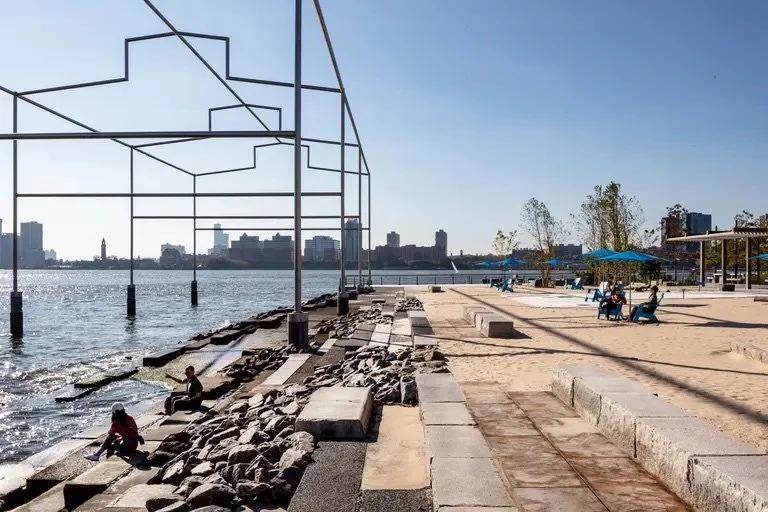Every borough in New York City now has a beach. Sort of. On Monday, the Gansevoort Peninsula officially opened at Little West 12th Street and 13th Avenue at Hudson River Park. The new 5.5-acre waterfront public park in the Meatpacking District includes a sandy beach with umbrellas, chairs, misting features, places to picnic, kayak access, and a rocky seating edge. But, unlike at other city beaches, swimming will not be allowed at Gansevoort Peninsula due to the Hudson River’s polluted water. The green space is the largest standalone recreational space within the four-mile Hudson River Park.
Lawn and sandy bluff with a view of “Day’s End.” Photo credit: Hudson River Park Trust
“This is how we do things in New York. We see beauty and potential, we roll up our sleeves and we get to work,” Gov. Kathy Hochul said. “This collaboration between New York City and State will benefit everyone who visits here on the shore of the Hudson, and it checks a lot of boxes from climate change mitigation to competition on the ball fields, from a stroll with your pup to sitting on the beach.”
Photo credit: Darren McGee/Office of Governor Kathy Hochul on Flickr
The site, located on the western end of Little West 12th Street and what remains of 13th Avenue, was once a parking lot used by the city’s Department of Sanitation. In 2019, the Hudson River Park Trust tapped Field Operations, the team behind the High Line and Domino Park, to lead the design of the park.
The $73 million project includes a sandy beach area with access for kayaks and small boats, a lawn, a seating area north of the waterfront, a sports field, two dog runs, lounge chairs, and a salt marsh with native grass and plantings. A boardwalk with a Pine grove connects the beach to the western esplanade where 13th Avenue was once located.
The salt marsh is found on the northern end of the park and includes a man-made underwater habitat with 20 million juvenile oysters, which will help create a healthy habitat for fish while also protecting the shoreline.
“Inspired by community input, Gansevoort Peninsula is a place for respite, relaxation, exploration, sports, and play,” Lisa Switkin, partner at Field Operations, said. “A defining characteristic is how the design embraces each side of the peninsula, offering new ways to engage with the Hudson River, with diverse and varied edges that elongate the transition from land to water.”
“Here, a combination of promenades, lookouts, tidal pools, ledges, sandy beach, salt marsh, and kayak access create an immersive and dynamic environment that changes with the tides, making for a truly unforgettable experience.”
The southern end of the park includes the art installation “Day’s End” by David Hammons. Gifted by the Whitney Museum of American Art, “Day’s End” serves as a “ghost monument” to a 1975 installation by Gordon Matta-Clark of the same name that was once located at Pier 52.
Hudson River balcony. Photo credit: Barrett Doherty
With the opening of Gansevoort Peninsula and the upcoming openings of Pier 97 and the science playground at Pier 26, the public portions of Hudson River Park are 95 complete. According to the Trust, Pier 97 will open later this fall with a large playground, ball sports zone, an overlook, and the playground at Pier 26 will open in the next few months.
“Beyond adding 5.5 new acres of extraordinary park to New York’s open space network, Gansevoort also connects communities to their Hudson River, completing a gap in the Park’s four-mile footprint, and making it infinitely more pleasurable to travel between our surrounding west side neighborhoods,” Noreen Doyle, president of the Hudson River Park Trust, said.
“We thank every member of the extraordinary design and construction teams and our own staff whose artistry and know-how came together to create this special place.”
Manhattan’s first public ‘beach’ opens at Hudson River Park
By Devin Gannon
October 2, 2023
Header photo: Gansevoort Peninsula at the southern edge with upland sandy bluff and “Day’s End.” Photo credit: Barrett Doherty

